Emotional regulation skills are the tools we use to manage what we feel, when we feel it, and how we choose to experience and express it. This isn't about bottling things up or pretending difficult feelings don't exist. It's about learning to respond to them in a way that’s healthy, intentional, and keeps you in the driver’s seat.
Mastering these skills is one of the most powerful things you can do for your well-being, especially when life gets complicated.
Why Emotional Regulation Matters for Adults
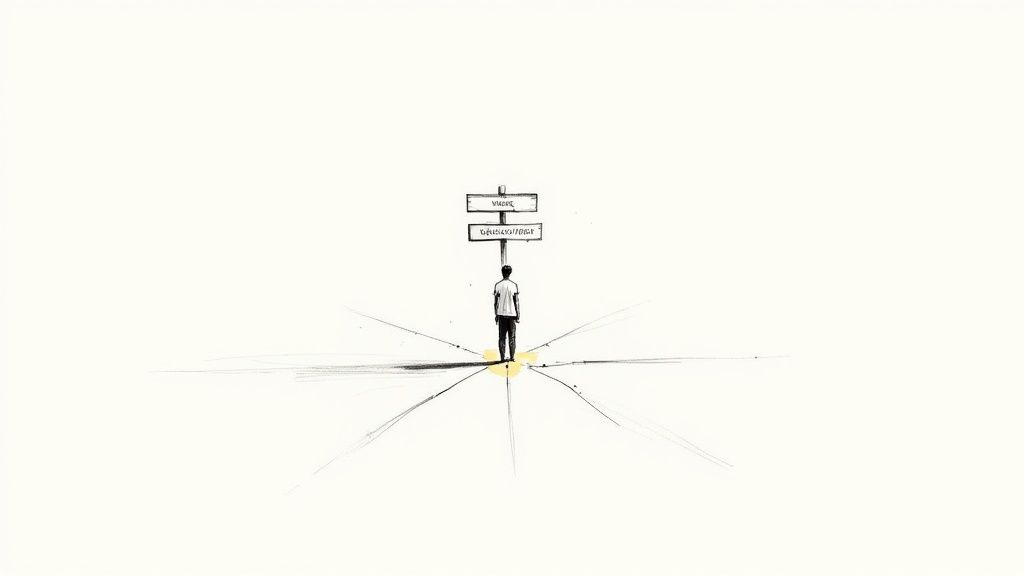
Let’s be honest: adult life is a minefield of emotional triggers. An unexpected bill, a conflict at work, a personal letdown—these things are guaranteed to happen. Without a solid set of skills to manage the feelings that follow, it’s easy to feel overwhelmed. That’s when we see impulsive reactions, strained relationships, and the kind of chronic stress that wears you down.
The thing is, nobody is born knowing how to do this. Emotional regulation isn't some innate talent; it's a skill set you have to learn and practice. Many of us were never taught how to sit with tough feelings or what to do when anger or sadness feels like it’s taking over. We might have learned to just stuff it down or, on the other end, let our emotions run the show completely.
The Impact of Unmanaged Emotions
When emotions are left to their own devices, they can cause serious disruption. Think about snapping at your partner after a brutal day at work or ghosting a friend to avoid a tough conversation. We’ve all been there. But when these moments become a pattern, they slowly chip away at our connections and our mental health.
This isn’t just a personal struggle; it’s a global one. Studies show that significant emotional dysregulation impacts roughly 9.2% of adults across various cultures. What’s more, research consistently shows that adults struggling with this report higher rates of anxiety, aggression, and trouble concentrating, which can throw a wrench into everything from their careers to their closest relationships.
The goal isn't to stop feeling. It's to stop being controlled by your feelings. True emotional regulation gives you the power to choose your response, turning emotional reactivity into thoughtful action.
Before diving into the "how-to," it helps to have a clear framework. At its core, emotional regulation involves four key abilities working together.
Core Components of Emotional Regulation
| Component | What It Means in Practice |
|---|---|
| Self-Awareness | The ability to notice and accurately label your emotions as they arise, without judgment. |
| Acceptance | Allowing yourself to experience the emotion, even if it's uncomfortable, rather than fighting it. |
| Adaptive Strategies | Knowing you have a toolkit of healthy coping skills and choosing the right one for the situation. |
| Goal-Directed Behavior | The capacity to stay focused on your long-term values and goals, even when intense emotions are present. |
Think of these components as the foundation. The skills we'll explore in this guide are the practical tools you use to build on that foundation.
Building a Foundation for Resilience
Ultimately, developing emotional regulation skills is about building resilience. It’s what empowers you to handle pressure without falling apart and to bounce back from setbacks faster and stronger.
This process boils down to a few key abilities:
- Awareness: Simply recognizing and naming what you’re feeling. "I'm feeling anxious right now." No judgment, just observation.
- Acceptance: Letting yourself feel that anxiety without immediately trying to push it away or fix it.
- Action: Intentionally choosing a constructive response that aligns with your values, rather than just reacting on impulse.
In a world that feels more stressful than ever, these skills have become non-negotiable for finding balance. Learning to manage your internal world gives you a stable footing, which in turn helps you build stronger relationships, sharpen your focus, and lead a more intentional, fulfilling life.
Your Toolkit for Immediate Emotional Relief
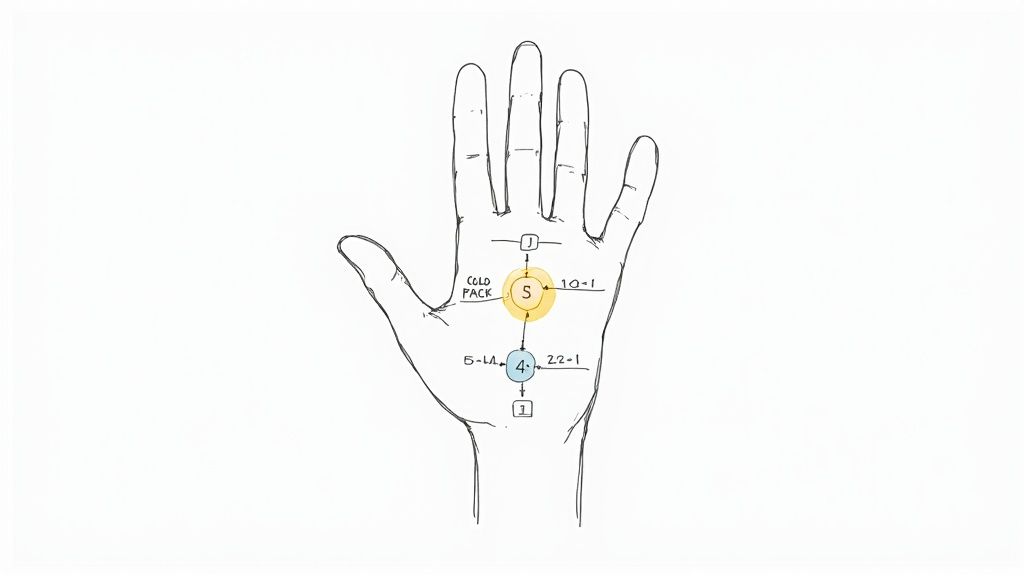
When a wave of intense emotion hits, you don’t have time to dig into a long-term strategy. You need something that works right now to keep your head above water. This toolkit is for those exact moments—when panic, anger, or overwhelming sadness threatens to take over.
These aren't just clever distractions. They're physiological and psychological tools designed to interrupt an escalating emotional response. By anchoring you in the present, they give your nervous system a chance to stand down so your thinking brain can come back online.
Ground Yourself with the 5-4-3-2-1 Method
One of the most powerful emotional regulation skills you can learn is grounding. When you're spiraling, your mind is usually stuck somewhere else—fixating on past regrets or future anxieties. Grounding yanks your focus back to the present moment using your five senses. It's simple, discreet, and surprisingly effective.
Imagine you're in a crowded grocery store and it all becomes too much. The lights feel blinding, the noise is deafening, and your heart starts pounding. Instead of bolting for the exit, you can pause and silently run through this exercise:
- 5 Things You Can See: Look around and name five objects. A red apple. A scuff on the floor. A bright yellow "Sale" sign. A child’s blue jacket. The metallic shine of the cart handle.
- 4 Things You Can Feel: Shift your awareness to physical sensations. The cool metal of the shopping cart in your hands. The solid pressure of your shoes on the ground. The texture of your jeans against your skin. A gentle breeze from the store's air conditioner.
- 3 Things You Can Hear: Listen closely for three specific sounds. The distant beep of a checkout scanner. The squeak of a wobbly cart wheel. The low hum of the refrigerators.
- 2 Things You Can Smell: What scents are in the air? Maybe the faint aroma from the bakery or the clean, earthy smell of the produce section.
- 1 Thing You Can Taste: Focus on the taste in your mouth. You could take a sip of water or simply notice the lingering flavor of your morning coffee.
This simple exercise forces your brain to pivot from abstract worry to concrete, sensory details. It breaks the momentum of panic and re-establishes your connection to the here and now.
Instantly Calm Your Nervous System with TIPP Skills
Sometimes an emotion is so intense that trying to "think" your way out of it feels impossible. That's where Distress Tolerance skills from Dialectical Behavior Therapy (DBT) come in. The TIPP technique uses your body's own biology to rapidly de-escalate a crisis when your mind is offline.
TIPP is an acronym for Temperature, Intense Exercise, Paced Breathing, and Paired Muscle Relaxation. These actions trigger a powerful physiological shift that dials down extreme emotional arousal.
Think of it as hitting a biological reset button. The "T" for Temperature is particularly potent, activating the mammalian "dive reflex" to signal your body to calm down almost instantly.
How to Use the Temperature Skill:
- Fill a bowl with cold water (adding ice helps).
- Hold your breath and submerge your face for 15-30 seconds.
- Make sure the area under your eyes and above your cheekbones gets cold.
This one action dramatically slows your heart rate, a change you can feel within seconds. It's an incredibly effective way to halt a panic attack or cool down fiery anger before you react.
Choosing Your In-the-Moment Tool
The best tool is the one you can actually use when you need it. Let's be real—you can't always splash cold water on your face. That’s why having a few different options is key.
The 5-4-3-2-1 method is discreet enough to do anywhere, from a business meeting to a crowded bus. TIPP skills, on the other hand, offer a more powerful intervention when you can find a private moment. These are just two examples of the many healthy coping mechanisms you can learn.
Some people also find that tangible aids like calming crystals for anxiety can be a helpful addition to these sensory techniques. The trick is to practice these skills when you're calm, so they become second nature when stress is high.
Building Long-Term Emotional Resilience
While grounding skills are lifesavers in a crisis, the real goal is to have fewer crises in the first place. That’s where emotional resilience comes in. Think of it as proactive work on your emotional foundation—like an athlete conditioning their body to prevent injuries, not just treating them after a fall.
This isn’t about quick fixes. It’s about sustainable practices that shift you from reacting to your emotions to intentionally shaping your responses. Over time, these strategies can fundamentally change your relationship with your feelings and build the kind of inner strength that lasts.
Rewire Your Perspective with Cognitive Reappraisal
One of the most powerful tools in any emotional regulation toolkit is cognitive reappraisal. It’s the skill of changing how you think about a situation to change how you feel about it. This isn't about toxic positivity or pretending a bad situation is great; it's about finding a more constructive and less painful lens to see it through.
Our first take on an event is often automatic, colored by old fears or insecurities. Say your boss gives you critical feedback on a project. The immediate, gut-punch thought might be, "I'm a complete failure." That interpretation is a direct pipeline to feelings of shame, anxiety, and wanting to hide under your desk.
Cognitive reappraisal is about challenging that first draft of the story. Instead of letting "I'm a failure" run the show, you can consciously reframe it.
Examples of Cognitive Reappraisal in Action:
-
Initial Thought: "I can't believe they canceled plans again. Nobody ever wants to hang out with me."
-
Reappraised Thought: "It’s disappointing they canceled, but it might have nothing to do with me. They could be swamped or just need a night in. I can check on them and still make plans with someone else."
-
Initial Thought: "I am so anxious about this presentation. I'm going to bomb it and everyone will think I'm an idiot."
-
Reappraised Thought: "It's normal to be nervous before speaking. This is a chance to share what I know. I've prepared for this, and if I stumble, I can handle it."
This simple shift doesn't erase the sting of disappointment or the jitters of anxiety, but it stops the feeling from spiraling into a catastrophe. It turns a dead end into a path forward.
Cultivate Awareness with Daily Mindfulness
Mindfulness is simply paying attention to the present moment without judging it. It’s a foundational skill for emotional regulation because you can’t manage what you aren’t aware of. By regularly checking in with your thoughts and feelings, you start to see them for what they are: temporary events passing through your mind, not absolute truths that define you.
You don't need to meditate on a cushion for an hour to get the benefits. You can weave small moments of awareness into your day.
- Mindful Coffee: Instead of scrolling on your phone, give your full attention to your morning coffee. Notice the warmth of the mug, the steam, the aroma, and the actual taste of each sip.
- 60-Second Body Scan: While sitting at your desk, take a minute to mentally scan your body. Where are you holding tension? A tight jaw? Shoulders hunched up by your ears? A knot in your stomach? Just notice it, and consciously breathe into that spot to let it soften.
Consistent mindfulness practice creates a crucial gap between an emotional trigger and your reaction. In that space, you find the freedom to choose a more skillful response.
Building resilience also means managing the external noise that fuels our internal stress. Exploring the social media detox benefits, for example, can be a huge step in reducing the anxiety and comparison that chip away at our emotional reserves.
Use DBT Skills to Change Unhelpful Cycles
Dialectical Behavior Therapy (DBT) is loaded with practical skills designed specifically for handling intense emotions. Two of the best for building long-term strength are "Check the Facts" and "Opposite Action." Getting familiar with what Dialectical Behavior Therapy is can give you a deeper understanding of these powerful tools.
Check the Facts
This is a more structured, detective-like version of cognitive reappraisal. When an emotion feels huge and overwhelming, it’s often because our interpretation of the facts is fueling the fire. "Check the Facts" walks you through a series of questions to separate objective reality from your emotional story.
- What's the emotion? (e.g., Intense fear.)
- What was the trigger? (e.g., My boss sent a one-word email: "Urgent.")
- What's my story about this? (e.g., "I'm definitely getting fired. I must have screwed something up badly.")
- What are the actual, provable facts? (e.g., The only fact is the email itself. The rest is an assumption I made up.)
- Does my emotion fit the facts? (e.g., Overwhelming fear is probably an overreaction to a one-word email. A more fitting response might be curiosity or mild concern.)
Opposite Action
Sometimes, our emotions give us urges that will only dig the hole deeper. The urge to isolate when you're depressed or to avoid things that make you anxious just reinforces the negative cycle. Opposite Action is about intentionally doing the opposite of what that unhelpful emotion is screaming at you to do.
-
Emotion/Urge: Sadness, which makes you want to stay in bed all day and shut the world out.
-
Opposite Action: Get up, take a shower, and go for a short walk around the block.
-
Emotion/Urge: Anxiety, which makes you want to cancel plans and avoid the social event.
-
Opposite Action: Go to the event, even if you only commit to staying for 30 minutes.
This skill is about behaving your way into a new way of feeling. When you act contrary to a negative emotion, you send a powerful message to your brain: this feeling doesn't have to be in the driver's seat.
How to Create a Personal Emotional Regulation Plan
Knowing what emotional regulation skills are is one thing, but actually using them when you're overwhelmed is a completely different ballgame. The real magic happens when you stop relying on a generic list and start building a personalized plan that maps your specific triggers to the skills that genuinely work for you.
Think of it as a roadmap for your own mind. When a big emotion hits, trying to recall a technique from memory is nearly impossible. A pre-made, custom guide takes the guesswork out of the equation, letting you respond with intention instead of just reacting on autopilot.
Identify Your Unique Emotional Triggers
The first step is to become a detective of your own emotional life. What specific situations, people, thoughts, or even physical feelings consistently light an emotional fuse? These are your triggers.
You have to get granular here. "Stress" is way too broad. What does stress actually look like for you? Is it the pressure of a looming deadline? A tense conversation with a family member? That knot of anxiety you get when an unexpected bill lands in your inbox?
For one week, keep a simple log. When you feel a powerful emotion bubble up, jot down the answers to these questions:
- What was happening right before I felt this? (The external event)
- What thoughts were running through my head? (The internal story)
- What did my body feel like? (e.g., tight chest, hot face, shaky hands)
- What was the main emotion? (e.g., anger, shame, fear)
This isn't about judging yourself. It's about gathering data. Understanding your patterns is the foundation for creating a plan that will actually support you when it counts.
Match the Right Skill to the Situation
Once you have a clearer picture of your triggers, you can build a targeted response plan. Not every skill is right for every situation. You wouldn't try to use a long-term strategy like cognitive reappraisal in the middle of a full-blown panic attack.
It's like having an emotional first-aid kit. You need different tools for a minor scrape than you do for a serious injury.
A personalized plan acknowledges that what works for one person or one emotion may not work for another. Customization is the difference between having a list of skills and having an effective strategy.
What works for you also depends on your unique circumstances. Research even shows that age can influence which strategies are most effective. For instance, one study found that expressive suppression—bottling up emotions—was linked to 21% less emotion dysregulation in older adults. But for younger adults, it was associated with 17% more dysregulation. You can read the full research on how age impacts regulation strategies. This just goes to show how vital it is to find what genuinely works for you.
This simple three-step process is a great visual for building resilience in the moment.
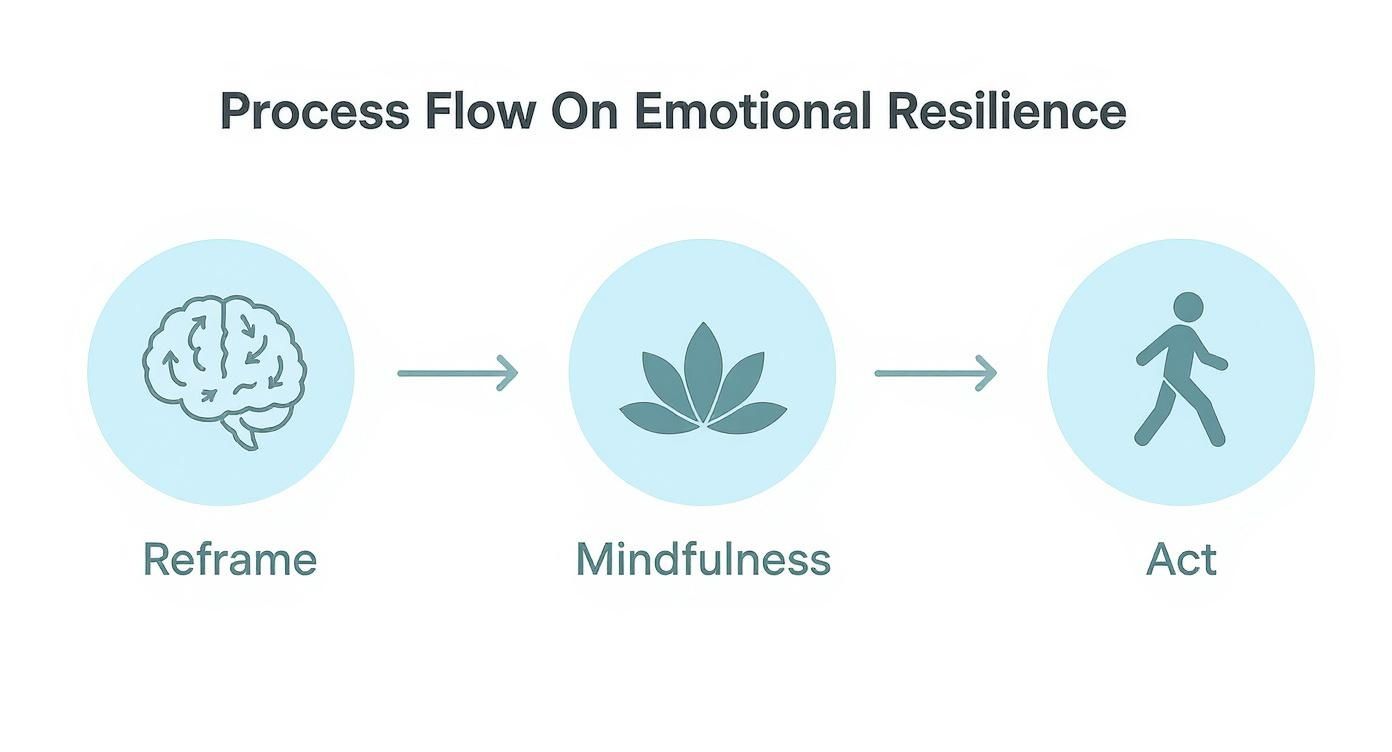
It reminds us to first reframe our thoughts, ground ourselves with mindfulness, and then take action that aligns with our values.
Create a Portable Coping Card
To make sure your plan is there when you need it most, shrink it down onto a "coping card." This could be an actual index card you keep in your wallet or just a note saved to your phone's home screen. The goal is quick, easy access in a high-stress moment.
Keep it simple. This is a crisis tool, not a detailed textbook. Use a straightforward format that links your most common triggers to your go-to skills.
Here's a sample table you can use as a starting point. It’s designed to connect the dots between a trigger, the resulting emotion, an immediate skill to use, and a longer-term strategy to practice later.
Sample Emotional Regulation Plan
| Trigger | Intense Emotion | Go-To Skill (Immediate) | Follow-Up Skill (Long-Term) |
|---|---|---|---|
| Negative feedback at work | Shame, Anxiety | Grounding: 5-4-3-2-1 method | Cognitive Reappraisal: "This is a chance to learn." |
| Conflict with my partner | Anger, Frustration | TIPP Skill: Cold water on face | Opposite Action: Express needs calmly instead of shutting down. |
| Feeling overwhelmed by my to-do list | Panic, Helplessness | Paced Breathing: 4 seconds in, 6 seconds out. | Mindfulness: Break tasks into small, single-focus steps. |
By filling this out for your own life, you create a powerful, personalized tool that can guide you through the stormiest emotional moments.
Adapt and Evolve Your Plan
Your emotional regulation plan isn't a static document you create once and forget about. Life changes, and so will your triggers and needs. A skill that felt like a lifesaver six months ago might not hit the same way today, and that’s perfectly okay.
Set a reminder to do a brief check-in with yourself once a month. Look over your plan and ask:
- Are these triggers still the most relevant ones?
- Are these skills still effective for me?
- Have new challenges popped up that I need a plan for?
- What have I learned about my emotional patterns this month?
This habit of ongoing refinement ensures your plan stays a living, useful tool. It shifts emotional regulation from a rigid set of rules into a dynamic and compassionate practice of self-awareness. By regularly updating your strategy, you are actively building your own resilience, one situation at a time.
Maintaining Your Skills and Navigating Setbacks
Learning to regulate your emotions is a practice, not a performance. Some days, you’ll navigate a tough conversation like a pro. Other days, an old, unhelpful reaction will sneak back in. That’s not failure. It’s just part of the messy, human process of building new habits in your brain.
The real goal isn’t perfection; it’s persistence. True maintenance is about how you handle those slip-ups—meeting them with curiosity instead of criticism. A setback is just data, a chance to get curious about what went wrong without letting one bad moment derail all your hard work.
What to Do When a Skill Doesn’t Work
So you tried your go-to grounding technique, but this time, it just isn’t cutting it. Your anxiety is still buzzing, or the frustration is still simmering. This is going to happen, which is why you need a troubleshooting plan ready to go.
When your primary skill falls short, it’s a signal to pivot, not to panic. Run through a quick mental checklist:
- Is the emotion just too intense right now? If you’re already at a 9 out of 10, a subtle skill like mindful breathing might feel like trying to stop a tidal wave with a bucket. You probably need a more powerful, body-based technique like TIPP to bring the intensity down first.
- Am I ignoring a basic physical need? Are you hungry, exhausted, or in pain? Sometimes, what feels like a massive emotional crisis is really just your body screaming for fuel or rest.
- Is this a brand-new trigger? A novel situation might require a different approach than what works for your usual stressors.
Beating yourself up over a setback is like pouring salt in the wound. A compassionate inner voice sounds more like, "Okay, that was rough, and my old reaction showed up. That's okay. What can I try next?" This mindset is everything when it comes to long-term success.
A setback is just a setup for a comeback. Every slip-up is an opportunity to strengthen your plan, deepen your self-awareness, and practice getting back on track with kindness.
The Power of Co-Regulation and Asking for Help
Emotional regulation was never meant to be a solo sport. Co-regulation is the process of calming your own nervous system by connecting with a safe, supportive person. It’s what a baby gets from a parent’s soothing voice, and it’s a tool we can—and should—use our entire lives.
Simply talking through a difficult feeling with a trusted friend, partner, or therapist can provide an external anchor when your internal one feels shaky. Their calm presence can literally help your own body settle down. This isn’t weakness; it’s resourcefulness.
Learning to ask for this kind of support is a skill in itself. It can sound like:
- "I'm feeling really overwhelmed right now. Could we just sit together for a few minutes?"
- "I’m struggling with my anger today. Can I talk through what’s going on with you?"
This ability to connect is deeply tied to our mental health. In fact, a person’s skill in managing their emotional expression is strongly linked to their overall psychological wellbeing. One study showed that adults with better regulation skills reported significantly higher wellbeing scores. You can discover more about the link between regulation and wellbeing in this research.
Knowing When to Seek Professional Support
While self-help skills are powerful, there are times when they just aren’t enough. This is especially true when you're also dealing with challenges like a substance use disorder or past trauma. Learning to re-engage after a setback can be especially difficult, as a single slip can trigger intense feelings of failure—a phenomenon often called the abstinence violation effect.
It might be time to look into an outpatient program if you notice these signs:
- Your emotional reactions consistently feel out of control, no matter what you try.
- Your relationships, work, or health are taking a serious hit.
- You find yourself falling back on unhealthy coping mechanisms, like substance use, to get through the day.
- You feel stuck, alone, and unable to move forward on your own.
Getting professional guidance from a therapist or a structured program gives you accountability, expert insight, and a safe community to practice your emotional regulation skills for adults. It’s not giving up—it’s an act of strength that gives you the scaffolding you need to build a more resilient life.
Common Questions About Emotional Regulation
As you start weaving these skills into your daily life, questions are bound to pop up. This isn't a one-size-fits-all process; your journey will look different from anyone else's. Let's tackle some of the most common questions to clear up any confusion and set some realistic expectations.
Think of this as the FAQ for your new emotional toolkit. The goal here is to reinforce your confidence and help you apply these strategies with a clearer head.
How Long Until I See a Real Difference?
This is the number one question, and the honest answer is: it varies. You’ll probably feel immediate relief from "in the moment" skills like the TIPP technique, which can stop a panic attack in its tracks. That’s an instant result.
But building deep, lasting emotional resilience with skills like cognitive reappraisal and mindfulness is more like building muscle. It's a gradual process. Most people start to notice a real shift in their baseline emotional state after a few weeks of consistent practice. We're not aiming for a quick fix, but for a sustainable change in how you relate to your feelings.
The most significant progress happens when you stop seeing these as emergency-only tools and start treating them like daily mental hygiene—just like brushing your teeth. Consistency beats intensity every time.
For instance, doing a two-minute mindful body scan every single day will build more long-term resilience than one intense, hour-long meditation session once a month. It’s the small, steady efforts that really compound over time.
Is It Possible to Master My Emotions?
The idea of "mastering" emotions can be a little misleading. It paints a picture of a future where you never feel angry, anxious, or sad again, which is not only unrealistic but also not very helpful. Emotions are data; they’re messengers telling us what we care about and what needs our attention.
The real goal of practicing emotional regulation skills for adults isn't to silence your emotions, but to master your response to them. It’s about building emotional agility—the ability to feel a powerful emotion without letting it hijack your behavior.
You’ll know you're making progress when you can:
- Notice anger rising without immediately lashing out.
- Feel anxious about a big presentation but still take the steps to prepare and deliver it.
- Experience a wave of sadness without it spiraling into a depressive episode.
This isn't about becoming emotionless. It's about being in a wise and healthy relationship with your emotions.
What if My Partner or Family Isn't Supportive?
This is a tough one, and it comes up a lot. When you start changing your emotional patterns, it can shake up the dynamics in your relationships. A loved one might be used to your old reactions and feel confused or even threatened by the new, more regulated you.
Your first priority has to be your own well-being. You can't control how other people react, but you can control how you communicate your needs and protect your progress.
Try using "I" statements to explain what you're doing. Instead of, "You need to stop yelling at me," you could say, "I'm working on staying calm during disagreements, and I need to take a five-minute break when voices get raised." This frames your needs without assigning blame.
Remember, co-regulation is a powerful tool, but it requires a willing partner. If you aren't getting that support at home, finding it with a therapist or in a support group becomes even more critical.
At Altura Recovery, we understand that building these skills is a journey, not a destination. Our outpatient programs provide the expert guidance and supportive community you need to turn knowledge into lasting change, helping you achieve real healing one step at a time. Learn more about how we can support you at https://www.alturarecovery.com.

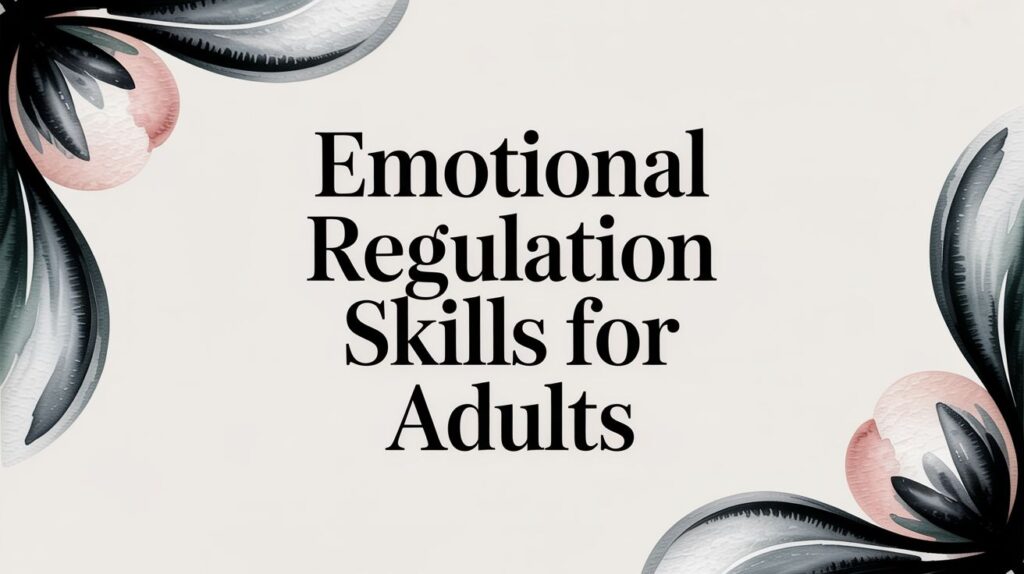
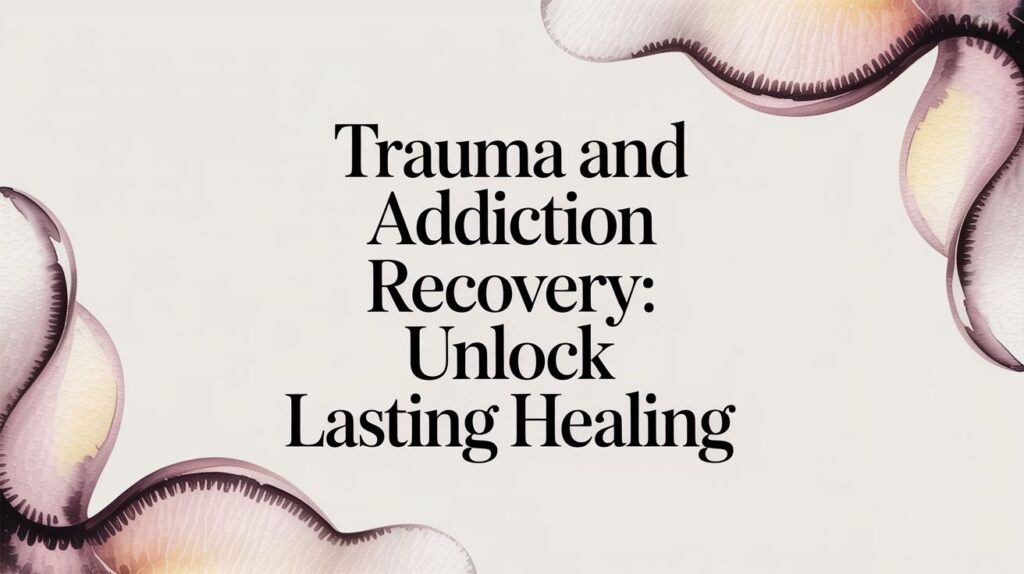

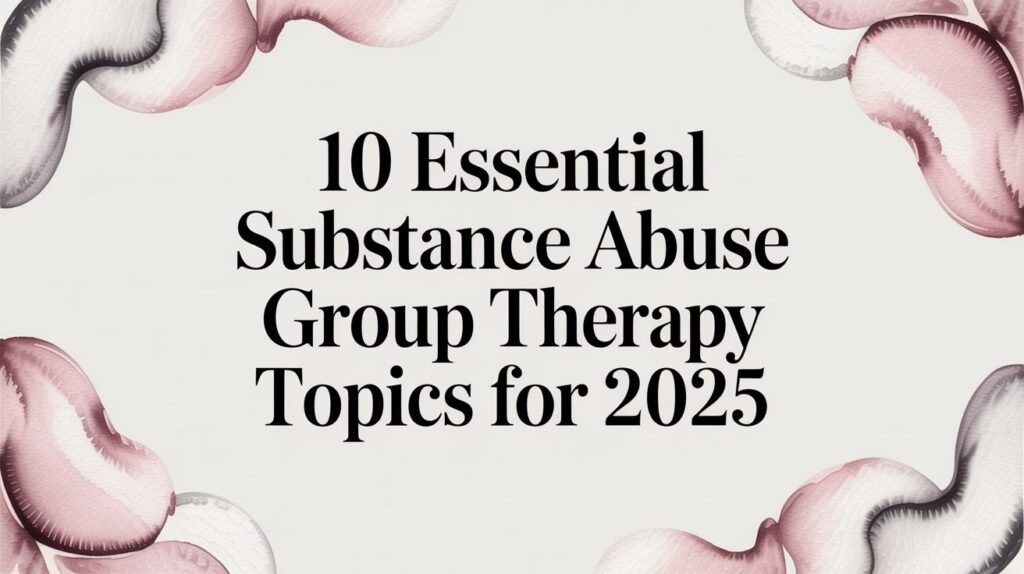
![Top 12 Dual Diagnosis Treatment Centers Texas [2025 Guide]](https://alturarecovery.com/wp-content/uploads/2025/11/thumbnail-21-1024x574.jpg)

